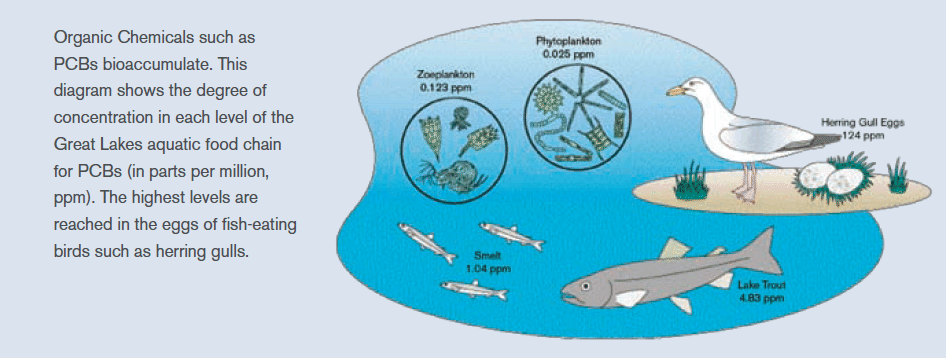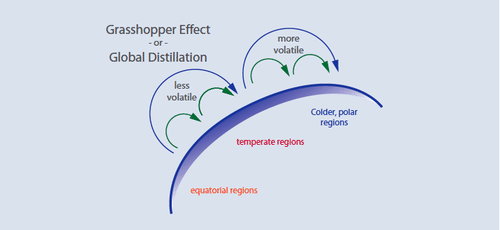10.4: Pests and Pesticides
- Page ID
- 27810
Pests and Pesticides
Pests are living organisms that occur where they are not wanted or that cause damage to crops or humans or other animals. A pesticide is a term for any substance or mixture of substances intended for preventing, destroying, repelling, or mitigating any pest. Though often misunderstood to refer only to insecticides, the term pesticide also applies to herbicides, fungicides, and various other substances used to control pests (EPA, 2015). By their very nature, most pesticides create some risk of harm—pesticides can cause harm to humans, animals, or the environment because they are designed to kill or otherwise adversely affect living organisms. At the same time, pesticides are useful to society—they can kill potential disease-causing organisms and control insects, weeds, and other pests.
Pest Control is a Common Tool
The management of pests is an essential part of agriculture and public health and an important tool in the maintenance of power lines and roads. Chemical pest management has helped to reduce losses in agriculture and to limit human exposure to disease vectors. Chemical pesticides can be effective, fast acting, adaptable to all crops and situations. When first applied, a plant protection strategy based exclusively on chemical pesticides can result in impressive production gains. However, despite these initial gains, excessive use of insecticides has proven to be ecologically unsound, leading to the destruction of natural enemies, the increase of pest resistance pest resurgence and outbreaks of secondary pests.
These consequences have often resulted in higher production costs and lost markets due to undesirable pesticide residue levels, as well as environmental and human health costs– side-effects which have been unevenly distributed. Despite the fact that the lion’s share of chemical pesticides are applied in developed countries, 99 percent of all pesticide poisoning cases occur in developing countries where regulatory, health and education systems are weakest. Many farmers in developing countries overuse pesticides and do not take proper safety precautions because they do not understand the risks and fear smaller harvests. Making matters worse, developing countries seldom have strong regulatory systems for dangerous chemicals: pesticides banned or restricted in industrialized countries are used widely in developing countries. Farmers’ perceptions of appropriate pesticide use vary by setting and culture. Prolonged exposure to pesticides has been associated with several chronic and acute health effects like non-Hodgkin’s lymphoma, leukemia, as well as cardiopulmonary disorders, neurological and hematological symptoms, and skin diseases.
Human health, Environmental, and Economic effects of pesticide us in potato production in Ecuador
The International Potato Center (CIP) conducted an interdisciplinary and inter-institutional research intervention project dealing with pesticide impacts on agricultural production, human health, and the environment in Carchi, Ecuador. Carchi is the most important potato-growing area in Ecuador, where smallholder farmers dominate production. They use tremendous amounts of pesticides for the control of the Andean potato weevil and the late blight fungus. Virtually all farmers apply class 1b highly toxic pesticides using hand pump backpack sprayers.
Research concerning pesticides has examined: neurological impacts on farmers and their families; poisoning incidence; studies of farmers’ attitudes, knowledge, and practices; economic impacts; and contamination of ground and surface water, clothing and body surfaces, food, and farmers’ homes. Intervention activities have included: farmer field schools, community meetings analyzing personal and household exposure pathways, promotion of safety measures, radio announcements, educational programs, and stakeholder workshops. The study found that the health problems caused by pesticides are severe and are affecting a high percentage of the rural population. Despite the existence of technology and policy solutions, Government policies continue to promote the use of pesticides. The study conclusions concurred with those by the pesticide industry, “that any company that could not ensure the safe use of highly toxic pesticides should remove them from the market and that it is almost impossible to achieve safe use of highly toxic pesticides among small farmers in developing countries.”
Source: Yanggen et al. 2003.
POPs
Persistent Organic Pollutants or POPs are a group of chemicals that includes 12 organic compounds [Aldrin, chlordane, DDT, dieldrin, dioxins, endrin, furans, heptachlor, hexachlorobenzene (HCB), mirex, polychlorinated biphenyls (PCBs), and toxaphene]. These compounds have been widely used as pesticides or industrial chemicals and pose risks to human health and ecosystems. POPs have been produced and released into the environment by human activity. They have the following three characteristics:
PERSISTENT: POPs are chemicals that last a long time in the environment. Some may resist breakdown for years and even decades while others could potentially break down into other toxic substances.
BIOACCUMULATIVE: POPs can accumulate in animals and humans, usually in fatty tissues and largely from the food they consume. As these compounds move up the food chain, they concentrate to levels that could be thousands of times higher than acceptable limits.
TOXIC: POPs can cause a wide range of health effects in humans, wildlife and fish. They have been linked to effects on the nervous system, reproductive and developmental problems, immune response suppression, cancer, and endocrine disruption. The deliberate production and use of most POPs has been banned around the world, with some exemptions made for human health considerations (e.g. DDT for malaria control) and/or in very specific cases where alternative chemicals have not been identified. However, the unintended production and/or the current use of some POPs continue to be an issue of global concern. Even though most POPs have not been manufactured or used for decades, they continue to be present in the environment and thus potentially harmful. The same properties that originally made them so effective, particularly their stability, make them difficult to eradicate from the environment.
POPs and Health
The relationship between exposure to environmental contaminants such as POPs and human health is complex. There is mounting evidence that these persistent, bioaccumulative and toxic chemicals (PBTs) cause long-term harm to human health and the environment. Drawing a direct link, however, between exposure to these chemicals and health effects is complicated, particularly since humans are exposed on a daily basis to many different environmental contaminants through the air they breathe, the water they drink and the food they eat. Numerous studies link POPs with a number of adverse effects in humans. These include effects on the nervous system, problems related to reproduction and development, cancer, and genetic impacts. Moreover, there is mounting public concern over the environmental contaminants that mimic hormones in the human body. As with humans, animals are exposed to POPs in the environment through air, water and food. POPs can remain in sediments for years, where bottom-dwelling creatures consume them and who are then eaten by larger fish. Because tissue concentrations can increase or biomagnify at each level of the food chain, top predators (like largemouth bass or walleye) may have a million times greater concentrations of PBT POPs than the water itself. The animals most exposed to PBT contaminants are those higher up the food web such as marine mammals including whales, seals, polar bears, and birds of prey in addition to fish species such as tuna, swordfish and bass (Figure below). Once POPs are released into the environment, they may be transported within a specific region and across international boundaries transferring among air, water, and land.

Figure \(\PageIndex{1}\): Bioaccumulation and biomagnification. U.S. EPA. Great Lakes: The Great Lakes Atlas: Chapter Four the Great Lakes Today - Concerns. January 2009
“Grasshopper Effect”
While generally banned or restricted, POPs and other PBTs make their way into and throughout the environment on a daily basis through a cycle of long-range air transport and deposition called the “grasshopper effect” or the “global distillation” processes. The “grasshopper” or “global distillation” processes, illustrated in Figure below, begin with the release of POPs into the environment. When POPs enter the atmosphere, they can be carried with wind currents, sometimes for long distances.

Figure \(\PageIndex{1}\): How POPs move throughout the environment. Source: Environment Canada. The Science and the Environment Bulletin. May/June 1998
Through atmospheric processes, they are deposited onto land or into water ecosystems where they accumulate and potentially cause damage. From these ecosystems, they evaporate, again entering the atmosphere, typically traveling from warmer temperatures toward cooler regions. They condense out of the atmosphere whenever the temperature drops, eventually reaching highest concentrations in circumpolar countries. Through these processes, POPs and other PBTs can move thousands of kilometers from their original source of release in a cycle that may last decades.
Pest Management Policies
A major policy development likely to have a significant impact on pest management in developing countries has been the Stockholm Convention. The convention went into force in May 2004 and aims to phase out the POPs, including some of the most hazardous pesticides (often referred to as the “dirty dozen”). See Box below for details on the relevant protocols.
Pest management related International conventions
- The Stockholm Convention on Persistent Organic Pollutants (POP) is a global treaty to protect human health and the environment from the chemicals that persist in the environment for extended periods of time and tend to accumulate in living tissues of various organisms. Being at the top of the food chain, humans tend to absorb the greatest concentrations of these POPs, resulting in serious disruptions of the endocrine system, suppression of the immune system, disruption of reproductive function, and various developmental abnormalities. In its initial phase, the Convention lists twelve chemicals to be phased out from production and use, among which nine are pesticides (aldrin, chlordane, DDT, dieldrin, endrin, heptachlor, hexachlorobenzene, mirex and toxaphene) and three non-pesticides (dioxins, furans and polychlorinated biphenyls). The Convention came into force in May 2004 upon the 50th ratification.
- The Rotterdam Convention on the Prior Informed Consent Procedure for Certain Hazardous Chemicals and Pesticides in International Trade is a global treaty adopted in 1998 to limit the potential risks posed by the production and trade in hazardous chemicals and pesticides. Countries lacking adequate infrastructure to monitor the import and use of such substances were particularly vulnerable. In the 1980s, UNEP and FAO developed voluntary codes of conduct and information exchange systems, culminating in the Prior Informed Consent (PIC) procedure introduced in 1989. The new Convention replaces this arrangement with a mandatory PIC procedure. PIC requires exporters trading in a list of hazardous substances to obtain the prior informed consent of importers before proceeding with the trade. As of 24 February 2004, the Rotterdam Convention entered into force after the 50th ratification.
- Montreal Protocol on Ozone Depleting Substances is an international treaty, adopted in 1987, to eliminate the production and consumption of chemicals that deplete the ozone layer. Principal among these chemicals is Methyl Bromide, widely used in agriculture as a fumigant for soil-borne pests and diseases, stored grains pests, and quarantine pests in fresh produce (fruits and vegetables, flowers).

